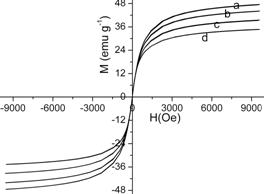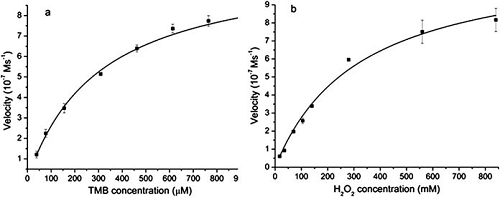最近研究发现氧化铁纳米颗粒新的性质——类似过氧化物酶的活性。过氧化物酶可作为临床诊断和免疫测定的一种试剂,其在分析化学中也具备重要意义。目前广泛商用的是辣根过氧化物酶(HRP),其价格昂贵,容易失活,在酶联免疫分析中因为分子较大而不利于和抗原抗体的结合,且标记过程复杂。因此,寻找能够替代HRP的模拟酶及催化体系并提高酶催化反应灵敏度是当前的研究热点。
Fe3O4在空气中易氧化,不稳定,导致可能的磁性和催化活性等性质的改变。相较于Fe3O4纳米粒子,γ-Fe2O3纳米粒子具备相似的磁性,却稳定的多。而通过预试验,我们发现其催化活性极弱,可能的原因是缺少Fe2+,因此,需要对γ-Fe2O3纳米粒子进行修饰,增强其催化活性,并保持其较强的磁性。
本文采用普鲁士蓝(PB)对γ-Fe2O3纳米粒子进行修饰,因其含有Fe2+,同时具备以下一些特性:(1)其表现出优秀的电化学行为,可加速电子转移;(2)其具有催化活性,可催化双氧水的还原;(3)其修饰到γ-Fe2O3纳米粒子表面后,暴露在表面的CN-带负电,与试验中使用的催化底物TMB具有较好的亲和性。实验结果表明:普鲁士蓝修饰的γ-Fe2O3纳米粒子(PBMNPs)具备较强的催化活性,且催化活性随着包被的PB的增多而增强,催化反应遵循米氏动力学。动力学常数显示PBMNPs和HRP相比,其与底物的亲和能力稍微欠佳,而催化效率基本在同一个数值上。PBMNPs和金黄色葡萄球菌蛋白A(SPA)复合后,仍保持良好的催化活性并能与IgG特异性结合,表现出其在生物分析上的优良前景。
Xiao-Qing Zhang, Shang-Wenyan Gong, Yu Zhang,* Ting Yang, Chun-Yu Wang and Ning Gu*, Prussian blue modified iron oxide magnetic nanoparticles and their high peroxidase-like activity, J. Mater. Chem., 2010, 20, 5110–5116.

Fig. 1 Schematic illustration of preparation of PBMNPs and immunoassays based on PBMNPs conjugated with SPA.

Fig. 2 TEM photographs of (a) γ-Fe2O3 NPs, (b) PBMNPs1, (c) PBMNPs2 and (d) PBMNPs3.

Fig. 3 FTIR spectra of (a) PBMNPs and (b) γ-Fe2O3 NPs.

Fig. 4 Hysteresis loops at room temperature of (a) γ-Fe2O3 NPs, (b) PBMNPs1, (c) PBMNPs2 and (d) PBMNPs3.

Fig. 5 Kinetic analysis for PBMNPs3 with (a) TMB and (b) H2O2 as substrates, respectively. A steady-state catalysis rate was calculated from the initial slopes of absorbance vs. time curves.

Fig. 6 Immunoassays based on the peroxidase-like activity of PBMNPs3.
Table 1 Comparison of the kinetic parameters of PBMNPs3 and HRP.
| [E]/M | Substrate | Km /mM | Vmax /M s-1 | kcat /s-1 | kcat/Km/M-1 s-1 |
PBMNPs3 | 3.09×10-10 | TMB | 0.307 | 1.06×10-6 | 3.43×103 | 1.1×107 |
| | H2O2 | 323.6 | 1.17×10-6 | 3.79×103 | 1.2×104 |
HRP[15] | 2.5×10-11 | TMB | 0.434 | 10.00×10-8 | 4.00×103 | 9.2×106 |
| | H2O2 | 3.7 | 8.71×10-8 | 3.48×103 | 9.4×105 |
[E] is nanoparticle and HRP concentration, Km is the Michaelis constant, Vmax is the maximal reaction velocity and kcat is the catalytic constant, where kcat = Vmax /[E]. Note that, kcat value shows catalytic efficiency per nanoparticle.